[ad_1]
It shouldn't be breaking news that there are loads of flash cards on the market of varying degrees of quality and “originality”, some with very complex relationships. There are clones of clones of copies, and keeping track of their history is important to some. For usability the main concern is a proven history of developer reliability. For example, the popular R4i SDHC is a clone of the DSTT but has a robust feature set and dependable updates.Please note that even if a card is a known clone, they may be well supported by professional teams of developers that are dedicated to updating their cards. A clone doesn't necessarily mean a bad and unreliable card, but there are many deliberately confusing labels.
Still, packaging is often used to distinguish between cards from different manufacturers. The R4 SDHC (beige box) comes from the manufacture of the R4i SDHC (red box), and they differ from the team that makes the first R4 SDHC (black box). A bad fake can mean instability or infrequent updates, but to date there has only been one card that's been known to cause harm to your DS console. The N5 card had a flaw in the design that caused a short and a blown fuse after so many insertions of the Micro SD card.
This is not a full review of each card, but an explanation of their provenance. The list is not exhaustive, and unpopular and discontinued cards were not included to save space. To get an idea of the breadth of clones produced, check out linfoxdomain.com for a list of all the firmware available.
Initial developers got started as early as the Game Boy Advanced and kept it up with crude slot 2 (bottom GBA slot on the DS and DS Lite) flash cards for the original DS console. Acknowledgement should be given to those teams and discontinued slot 2 cards for laying the groundwork. Some of them are still at work today, including the Supercard team. Since then, there have been a lot of migration of developers adding to the confusion of who was making which card.
More advanced slot-1 cards came into development as Slot-2 cards fell out of disfavor, and the R4 Revolution card quickly rose to the top in popularity. The R4 v2 is an upgrade mainly in the removal of the spring-clip SDHC slot. The R4 team and the M3 team are closely related, if not the same team, and the M3DS Simply was a rebranded R4v2 with new firmware, as opposed to an unlicensed clone card. The M3DS Real is a legitimate upgrade and not a clone of the M3DS Simply. The iTouch series comes from the M3 Team, designed as an entry level to their family of cards. The M3i SDHC and the M3i Upgrade are fakes that are NOT from the M3 Team and should not be relied upon.
There have been more clones and rebranding of the R4 line than any other card. While bearing the same name as R4, various manufacturers have no affiliation to the original R4 team and develop their own card families and software. There are four main distinct manufacturers who produce an “R4” card. The original R4 team is defunct, then there are the makers of the first R4 SDHC, the people who make the R4i SDHC (red box) started with a clone of the DSTT and they also make the R4i Gold, the R4 Ultra team is less popular but still prevalent, and to add to the confusion, the M3 team developed their own R4i RTS (white box).
Cards from other teams were in development at the time or soon after the R4DS. They are original technologies in their own right and not clones of other cards; the DSTT, the EZFlash V, the Acekard, the Supercard DSONE, and the CycloDS Evolution. The Supercard team claims that the CycloDS card is a clone of theirs but this claim has not been substantiated. It is generally considered that the CycloDS is superior to the Supercard DSONE, and proved so valued (if expensive) that it spawned the immensely popular Edge card as a clone.

